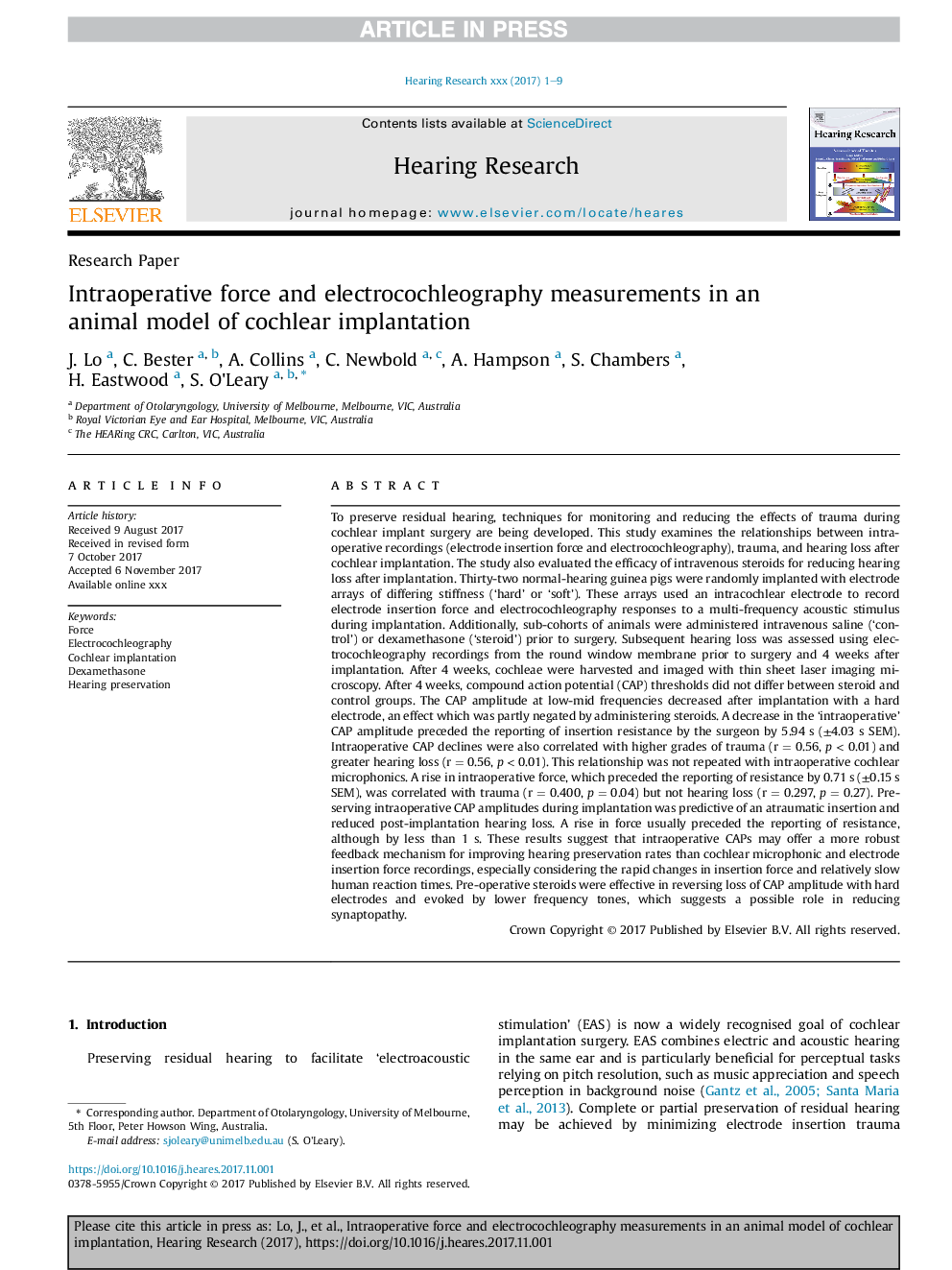| کد مقاله | کد نشریه | سال انتشار | مقاله انگلیسی | نسخه تمام متن |
|---|---|---|---|---|
| 8842428 | 1615542 | 2018 | 9 صفحه PDF | دانلود رایگان |
عنوان انگلیسی مقاله ISI
Intraoperative force and electrocochleography measurements in an animal model of cochlear implantation
ترجمه فارسی عنوان
اندازه گیری نیروی تعاملی و الکتروکوکلووگرافی در یک مدل حیوانی از کاشت حلزون
دانلود مقاله + سفارش ترجمه
دانلود مقاله ISI انگلیسی
رایگان برای ایرانیان
کلمات کلیدی
زور، الکتروکچلیوگرافی، کاشت حلزون، دگزامتازون، حفظ شنوایی،
موضوعات مرتبط
علوم زیستی و بیوفناوری
علم عصب شناسی
سیستم های حسی
چکیده انگلیسی
To preserve residual hearing, techniques for monitoring and reducing the effects of trauma during cochlear implant surgery are being developed. This study examines the relationships between intraoperative recordings (electrode insertion force and electrocochleography), trauma, and hearing loss after cochlear implantation. The study also evaluated the efficacy of intravenous steroids for reducing hearing loss after implantation. Thirty-two normal-hearing guinea pigs were randomly implanted with electrode arrays of differing stiffness ('hard' or 'soft'). These arrays used an intracochlear electrode to record electrode insertion force and electrocochleography responses to a multi-frequency acoustic stimulus during implantation. Additionally, sub-cohorts of animals were administered intravenous saline ('control') or dexamethasone ('steroid') prior to surgery. Subsequent hearing loss was assessed using electrocochleography recordings from the round window membrane prior to surgery and 4 weeks after implantation. After 4 weeks, cochleae were harvested and imaged with thin sheet laser imaging microscopy. After 4 weeks, compound action potential (CAP) thresholds did not differ between steroid and control groups. The CAP amplitude at low-mid frequencies decreased after implantation with a hard electrode, an effect which was partly negated by administering steroids. A decrease in the 'intraoperative' CAP amplitude preceded the reporting of insertion resistance by the surgeon by 5.94 s (±4.03 s SEM). Intraoperative CAP declines were also correlated with higher grades of trauma (r = 0.56, p < 0.01) and greater hearing loss (r = 0.56, p < 0.01). This relationship was not repeated with intraoperative cochlear microphonics. A rise in intraoperative force, which preceded the reporting of resistance by 0.71 s (±0.15 s SEM), was correlated with trauma (r = 0.400, p = 0.04) but not hearing loss (r = 0.297, p = 0.27). Preserving intraoperative CAP amplitudes during implantation was predictive of an atraumatic insertion and reduced post-implantation hearing loss. A rise in force usually preceded the reporting of resistance, although by less than 1 s. These results suggest that intraoperative CAPs may offer a more robust feedback mechanism for improving hearing preservation rates than cochlear microphonic and electrode insertion force recordings, especially considering the rapid changes in insertion force and relatively slow human reaction times. Pre-operative steroids were effective in reversing loss of CAP amplitude with hard electrodes and evoked by lower frequency tones, which suggests a possible role in reducing synaptopathy.
ناشر
Database: Elsevier - ScienceDirect (ساینس دایرکت)
Journal: Hearing Research - Volume 358, February 2018, Pages 50-58
Journal: Hearing Research - Volume 358, February 2018, Pages 50-58
نویسندگان
J. Lo, C. Bester, A. Collins, C. Newbold, A. Hampson, S. Chambers, H. Eastwood, S. O'Leary,
